List of crewed spacecraft
This is a list of crewed spacecraft types, including space stations, sorted by status, nation and series in chronological order.
Comparison
Current Crewed Spacecraft
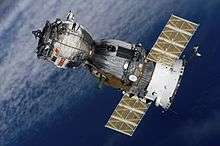
Soyuz-TMA spacecraft
Russia
- Soyuz (1967–present) 3 person Earth orbital spacecraft;[1] Early versions were operated by the Soviet Union and later versions by Russia after 1991. As of June 2018 Soyuz has made 137 crewed spaceflights, including 1 emergency sub-orbital flight (Soyuz 18a). There have been 2 accidental spacecraft losses resulting in the deaths of four cosmonauts (Soyuz 1 and Soyuz 11). Soyuz is the only spacecraft to have successfully saved the lives of a crew using the rocket launch escape system, when in 1983 Soyuz T-10-1 exploded on the launchpad. This spacecraft type has flown more times than any other spacecraft, including the Space Shuttle.[2]
China
- Shenzhou (2003–present) 3 person Earth orbital spacecraft. 6 flights as of April 2018. Shenzhou is China's first crewed spacecraft. On 13 October 2003 Yang Liwei was carried into space by Shenzhou 5 becoming China's first Taikonaut.[3]
Current Space Stations

International Space Station
International
- International Space Station (2000–present). Low earth orbit modular space station. The International Space Station is a joint project among five participating space agencies: NASA, Roscosmos, JAXA, ESA, and CSA.[4] Uncrewed initial assembly 1998-2000. Continuously crewed since November 2000. As of June 2018 ISS has been visited by 92 crewed spacecraft (57 Soyuz and 35 Space Shuttle). The ISS is the largest space station yet constructed. Planned to operate until 2024, with a possible extension to 2028.[5]
China
- Tiangong 2 (2016–present). Low earth orbit space station. China's second space station. Visited by one crew in 2016. Currently unoccupied. Not expected to receive further crews as China is scheduled to begin construction of a new modular space station in 2020.[6]
Former Crewed Spacecraft
Soviet Union
- Vostok (1961–1963) single-person Earth orbital spacecraft[7] 6 flights. On April 12, 1961 Vostok 1 carried the first human into space, Cosmonaut Yuri Gagarin.[8] On 16 June 1963 Vostok 6 carried the first woman into space, Cosmonaut Valentina Tereshkova.[9]
- Voskhod (1964–1965) 3 person Vostok derivative[10] 2 flights. On 18 March 1965 Alexey Leonov performed the first spacewalk in history, from Voskhod 2 - which was also the first multi-crew mission.[11]
United States
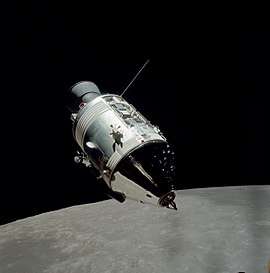
Apollo 17 CSM orbiting the Moon.
- Mercury (1961–1963) single-person Earth orbital spacecraft[12] 6 flights (including 2 sub-orbital). Mercury was the United States first crewed spacecraft. On 05 May 1961 Mercury-Redstone 3 carried the first American, Alan Shepard, into space on a sub-orbital flight. On 20 February 1962 Mercury-Atlas 6 carried the first American, John Glenn, into earth orbit.[13]
- Gemini (1965–1966) 2 person Earth orbital spacecraft[14] 10 flights. On 3 June 1965 Ed White made America's first spacewalk, from Gemini 4.[15]
- Apollo (1968-1975) 3 person Lunar capable spacecraft. 15 flights; including 9 lunar missions (with 6 lunar landings). It was the Apollo spacecraft that enabled America to win the Space Race. In December 1968 Apollo 8 was the first crewed spacecraft to orbit the moon. On 21 July 1969 Neil Armstrong, Commander of Apollo 11, became the first human being to walk on the moon.[16] The Apollo Spacecraft comprised
- 1. Command/Service Module (1968–1975) 3 person Earth and lunar orbital craft[17]
- 2. Lunar Module (1969–1972) 2 person lunar lander[18]
- Space Shuttle (1981–2011) 8 person Earth orbital spacecraft; first orbit-capable spaceplane; first partially reusable orbital spacecraft. 135 flights were made in 5 shuttles; Columbia, Challenger, Discovery, Atlantis and Endeavour, of which 2 (Challenger and Colombia) were accidentally destroyed resulting in the deaths of 14 astronauts during missions STS-51-L and STS-107.[19]
Suborbital
- X-15 (1963) single seat, air-launched spaceplane; two X-15 flights above the Kármán line occurred in 1963[20]
- SpaceShipOne (2004) single seat, air-launched spaceplane; three flights above the Kármán line occurred in 2004.[21]
Former Space Stations
Soviet/Russia
- Salyut series (1971–1991). Low earth orbit space stations. [22] Salyut 1 (1971), Salyut 4 (1974-1977), Salyut 6 (1977-1982), and Salyut 7 (1982-1991). All now de-orbited.[23]
- Almaz series (1973–1977) Military reconnaissance low earth orbit space stations. Badged as Salyut 3 (1974-1975), and Salyut 5 (1976-1977) as disinformation. Both now de-orbited.[23]
- Mir (1986–2000). Low earth orbit space station. The first modular space station in history. 28 crews. Mir was visited by 29 Soyuz and 7 Space Shuttle missions. De-orbited 2001.[24]
United States
China
- Tiangong 1 (2011–2012). Low earth orbit space station. China's first space station. 2 crews. De-orbited 2018.[26]
Crewed Spacecraft - In development
.jpg)
Dragon 2 spacecraft conducting a propulsive hover test
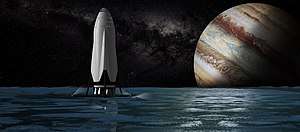
Artist's impression of the Big Falcon Spaceship on the Jovian moon Europa.
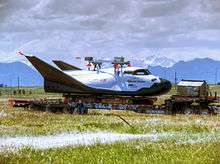
Dreamchaser on the day of its initial captive carry test
United States
- SpaceX's Dragon V2 - a 7 person Earth orbital spacecraft designed to transport astronauts to the International Space Station under the NASA Commercial Crew Contract. Dragon V2 is capable of operating beyond Earth orbit. First crewed flight planned for January 17 2019.[27]
- Boeing's CST-100 Starliner - a 7 person Earth orbital spacecraft designed to transport astronauts to the International Space Station under the NASA Commercial Crew Contract - first crewed flight likely in 2019[28]
- SpaceX's Big Falcon Spaceship (BFS) launched on the reusable Big Falcon Rocket (BFR) - 100+ person beyond Earth orbit craft (crew size expected to be smaller on early flights).[29][30] The BFS is primarily designed to enable crewed missions to Mars, but could in theory land on any rocky body in the Solar System (except Venus). Elon Musk CEO of SpaceX has stated that BFS test flights are expected to begin in 2019.[31]
- NASA's Orion - a 4 person beyond Earth orbit spacecraft. [32] The first crewed flight Exploration Mission 2 is planned to be launched for Lunar orbit on the Space Launch System in 2023.[33]
- Sierra Nevada's Dream Chaser - 7 person Earth orbital space plane[34] Uncrewed cargo version scheduled to fly in 2020 - a crewed version could subsequently be developed.
Sub-orbital
- Blue Origin's New Shepard - a 6 person capsule mounted on a reusable vertical launch sub-orbital rocket aimed at the space tourism market. As of April 2018 there have been 8 successful uncrewed flights since 2015 (2 atmospheric & 6 sub-orbital), with 7 successful rocket booster landings. First crewed test-flight expected in 2018. [35]
- Virgin Galactic's SpaceShipTwo - an 8 person air-launched suborbital space plane aimed at the space tourism market. On 31 October 2014 during a test flight, VSS Enterprise, the first SpaceShipTwo craft, broke up in flight and crashed in the Mojave desert.[36][37][38][39] One pilot was killed[40][41] The second SpaceShipTwo spacecraft, VSS Unity, was unveiled on 19 February 2016.[42][43] The new vehicle is undergoing flight testing with powered test flights in the atmosphere re-started in 2018.[44]
China
- Reusable Lift-body Launcher - China plans to launch its reusable spaceplane in 2020, according to a statement from China Aerospace Science and Technology Corporation.[45]
- Chinese winged rocket - the plane may one day fly up passengers to the edge of space. Two versions: one should be able to fly five people to an altitude of 100 kilometres; other - could fly 20 people to 130 kilometres. Payload launches in 2020.[46]
Russia
- RSSC - a reusable sub-orbital space complex, currently being developed by a private company KosmoKurs. First flight planned for 2021.[47][48]
- Federatsiya - a 4 person Lunar capable spacecraft. First crewed flight planned for 2024.[49]
India
- Gaganyaan - a 3 person Earth orbital spacecraft intented to be the first spacecraft under Indian Human Spaceflight Programme. Gaganyaan is capable of operating at Low Earth orbit for 7 days. The upgraded version will be equipped with rendezvous and docking capabilities. First crewed flight planned in 2022.
Japan
- A sub-orbital rocket plane currently being developed by PD Aerospace. First flight planned for 2020 and fully operational by 2023.[50]
United Kingdom
- Skylon - an unpiloted reusable space plane with possible passenger module (engine in development).[51]
- Thunderstar - a 12 metre manned rocket for one person.[52]
Space stations in development
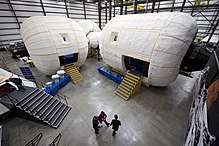
Mockup of Bigelow's Space Station
- Chinese large modular space station (CSS) - scheduled to start with the launch of the Tianhe-1 module in 2020, and to be completed by 2022[53]
- Bigelow Commercial Space Station or Space Complex Alpha, proposed private space habitat scheduled for 2020 initial deployment. A Bigelow test module is currently installed on the International Space Station.[54]
- Lunar Orbital Platform-Gateway (formally the Deep Space Gateway) - NASA proposed international crewed space station orbiting the Moon to be assembled by Orion missions between 2023-2027.[55]
- OPSEK, proposed Russian successor to the International Space Station.[56]
See also
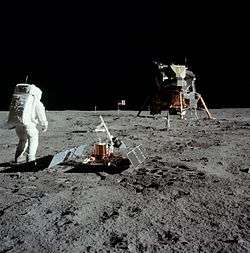
Apollo 11 Lunar Module
References
- ↑ Gatland, pp.148-165
- ↑ Hollingham, Richard. "Soyuz: The Soviet space survivor".
- ↑ "Shenzhou Manned Spacecraft Programme". Aerospace Technology. 2012-06-16. Retrieved 2018-08-26.
- ↑ "Human Spaceflight and Exploration—European Participating States". European Space Agency (ESA). 2009. Retrieved 17 January 2009.
- ↑ "International Space Station: Facts, History & Tracking".
- ↑ "Chinese space program insights emerge from National People's Congress - SpaceNews.com". 2 April 2018.
- ↑ Gatland, pp.109-115
- ↑ "Archived copy" (PDF). Archived from the original (PDF) on 2017-02-07. Retrieved 2018-04-02.
- ↑ "Valentina Tereshkova: First Woman in Space".
- ↑ Gatland, pp.131-113
- ↑ "The First Spacewalk".
- ↑ Gatland, pp.148, 151-165
- ↑ Loff, Sarah (6 April 2015). "About Project Mercury".
- ↑ Gatland, pp.166-185, 266-275
- ↑ "The First U.S. Spacewalk - Gemini 4". nssdc.gsfc.nasa.gov.
- ↑ "What Was the Apollo Program?". 24 February 2015.
- ↑ Gatland, pp.190, 278-280
- ↑ Gatland, pp.191, 207, 283, 284
- ↑ Taylor, Alan. "The History of the Space Shuttle".
- ↑ Long, Tony (2007-07-19). "July 19, 1963: Cracking the 100-Kilometer-High Barrier ... in a Plane". Advance Publications. Retrieved 18 November 2011.
- ↑ "SpaceShipOne: The First Private Spacecraft - The Most Amazing Flying Machines Ever".
- ↑ Gatland, pp.229-246
- 1 2 "Space Station - The Station - Russian Space History". www.pbs.org.
- ↑ "Mir Space Station". history.nasa.gov.
- ↑ "History of the NASA Skylab, America's first space station".
- ↑ "Space lab comes down over South Pacific". 2 April 2018 – via www.bbc.co.uk.
- ↑ "ISS Calendar – Spaceflight101 – International Space Station". spaceflight101.com.
- ↑ "Boeing Starliner Flight Test Slips – Parabolic Arc". www.parabolicarc.com.
- ↑ "SpaceX's Mars plans call for massive 42-engine reusable rocket - SpaceNews.com". 27 September 2016.
- ↑ "6 things to know as Elon Musk reveals bold deep-space strategy with largest rockets ever built". 29 September 2017.
- ↑ Georgiou, Aristos (2017-09-29). "Elon Musk at SXSW: Mars Spaceship Will Be Ready for First Flights by 2019". Newsweek.com. Retrieved 2018-08-26.
- ↑ "Orion Quick Facts" (PDF). NASA. Retrieved 25 January 2016.
- ↑ "NASA's 1st Manned Flight of Orion Space Capsule May Slip to 2023".
- ↑ Ferster, Warren (2011-04-18). "NASA Announces CCDev 2 Awards". Imaginova Corp. Retrieved 18 November 2011.
- ↑ "6 Reasons to Upgrade to RebelMouse from WordPress". 10 May 2017.
- ↑ Chang, Kenneth; Schwartz, John (31 October 2014). "Virgin Galactic's SpaceShipTwo Crashes in New Setback for Commercial Spaceflight". New York Times. Retrieved 1 November 2014.
- ↑ Foust, Jeff (2014-10-31). "SpaceShipTwo Destroyed in Fatal Test Flight Accident". Space News. Retrieved 2014-10-31.
- ↑ "Virgin Galactic's SpaceShipTwo Crashes During Flight Test". October 31, 2014.
- ↑ Durden, Rick (31 October 2014). "Virgin Galactic's SpaceShipTwo Crashes". AVweb. Retrieved 31 October 2014.
- ↑ Klotz, Irene (2014-11-03). "SpaceShipTwo's Rocket Engine Did Not Cause Fatal Crash". Discovery News. Retrieved 2014-11-03.
- ↑ "Virgin Galactic's SpaceShipTwo rocket plane crashes". October 31, 2014.
- ↑ "New SpaceShipTwo Rollout Friday". AVweb. Retrieved 19 February 2016.
- ↑ "Virgin Galactic unveils new space tourism rocket plane". CBC News. 19 February 2016. Retrieved 20 February 2016.
- ↑ "SpaceShipTwo's 2018 test campaign returns to powered flight – NASASpaceFlight.com". www.nasaspaceflight.com.
- ↑ "China will launch a reusable spaceplane in 2020 – NextBigFuture.com". www.nextbigfuture.com.
- ↑ "China plans world's biggest spaceplane to carry 20 tourists".
- ↑ "Archived copy". Archived from the original on 2016-11-14. Retrieved 2016-11-13.
- ↑ "КосмоКурс - Главная". www.cosmocourse.com.
- ↑ "Russia's next-generation spacecraft aims for 2023 crew launch". www.russianspaceweb.com.
- ↑ Chandran, Nyshka (12 April 2017). "SpaceX doesn't scare Asia's space players".
- ↑ "Who will win the battle of cheap space, spaceplanes or super rockets?".
- ↑ "Starchaser Industries Commercial Space Access • The sky is not the limit!". Starchaser.co.uk. 2017-09-11. Retrieved 2018-08-26.
- ↑ "China readying for space station era: Yang Liwei - Xinhua - English.news.cn". www.xinhuanet.com.
- ↑ "A new company plans to launch huge, inflatable spacecraft into orbit — and sell reservations to countries and tourists".
- ↑ Warner, Cheryl (13 February 2018). "NASA's Lunar Outpost will Extend Human Presence in Deep Space".
- ↑ "Orbital Piloted Assembly and Experiment Complex, OPSEK". www.russianspaceweb.com.
Sources
- Gatland, Kenneth (1976). Manned Spacecraft (2nd ed.). New York City: MacMillan Publishing Co., Inc. ISBN 0-02-542820-9.
This article is issued from
Wikipedia.
The text is licensed under Creative Commons - Attribution - Sharealike.
Additional terms may apply for the media files.
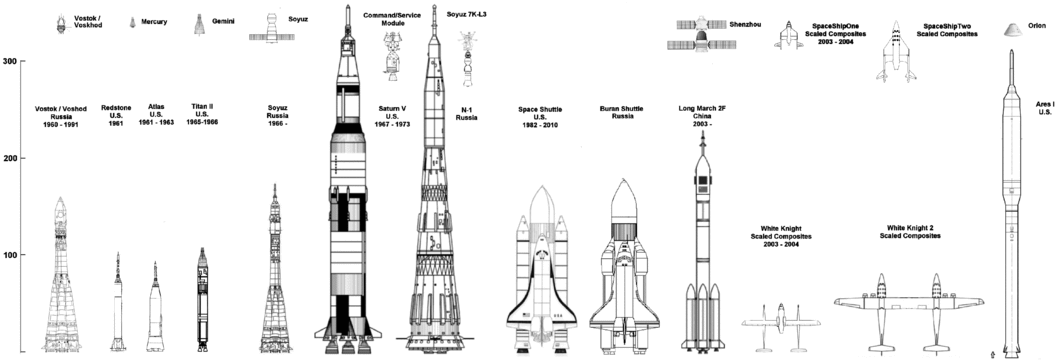
.jpg)